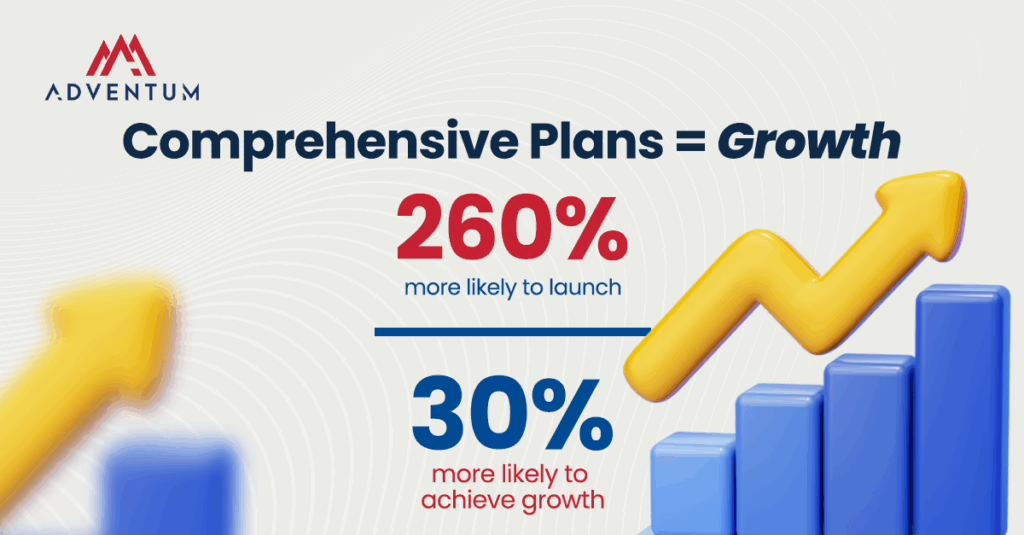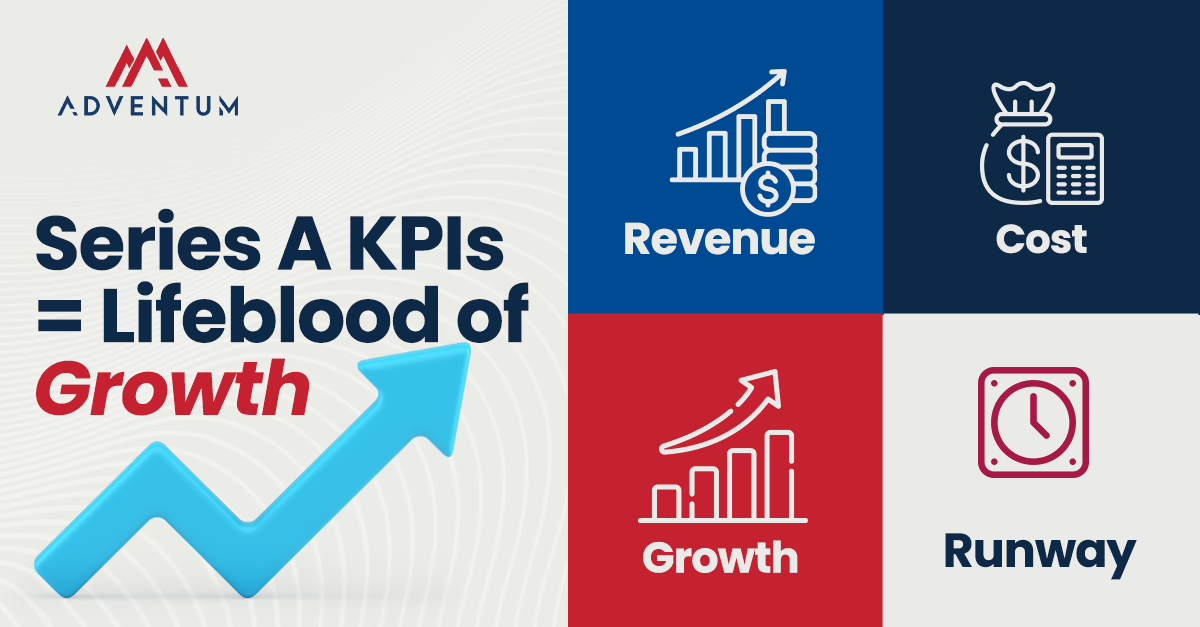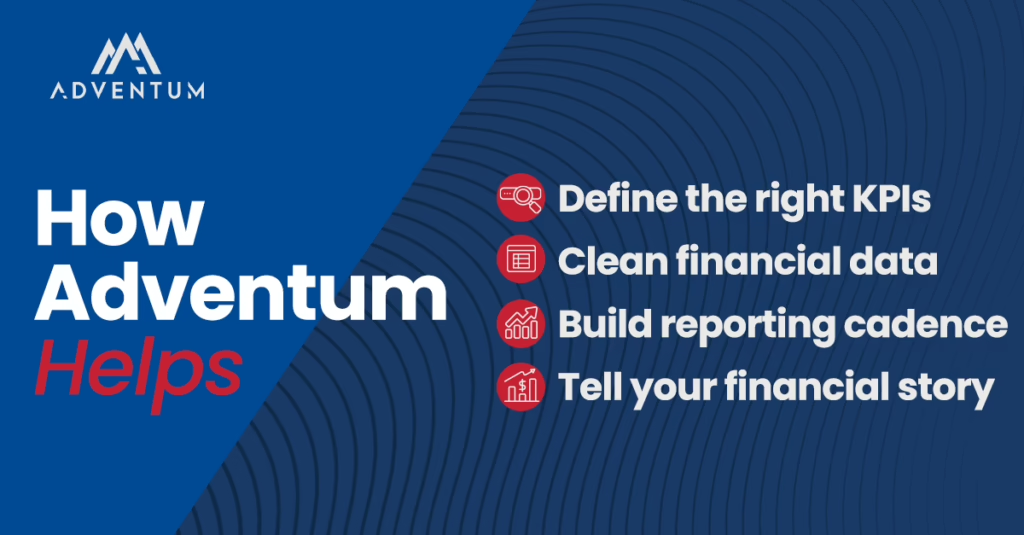Startup financial KPIs measure a company’s health, growth, and performance after raising a Series A. From revenue and cash efficiency to retention and operating metrics, the right KPIs give founders clarity, control, and credibility while avoiding common mistakes like vanity metrics and inconsistent reviews.
Raising your Series A is a milestone. It’s validation, momentum, and finally, a bit of breathing room. But once the high-fives fade and the wire hits, a new reality sets in:
This isn’t just about vision anymore.
You’re no longer just selling the dream. You’re expected to deliver results. And while you may have raised money on the strength of your story, you’ll keep it—and earn the next round—based on your numbers.
When the stakes change and the questions shift from “what’s possible?” to “what’s working?”, it can feel disorienting.
The good news? Startup financial KPIs give you clarity and control. They help you understand what’s driving your business, develop comprehensive financial plans, keep your burn in check, and speak the language investors expect.
Startups with comprehensive business plans are 260% more likely to launch and 30% more likely to achieve growth.

In this post, we’ll break down the key metrics for startups that matter most after Series A, from revenue growth to customer retention to cash runway. No fluff. No vanity metrics. Just the KPIs that help founders lead with confidence.
What Are Startup Financial KPIs, and Why Do Series A Startups Need Them?
Let’s set the stage.
Financial KPIs (Key Performance Indicators) are quantifiable metrics that provide insight into the economic health and trajectory of your company. They’re not just numbers, they’re signals. They help you make informed decisions, set clear goals, and effectively communicate with stakeholders.
Unlike general business metrics, Series A financial metrics directly tie to revenue, cost, growth, and runway —also known as the lifeblood of a company.

Why Metrics Matter Post-Series A
Once you raise a Series A, the expectations change.
Investors want proof, not promises. You’ve got funding, but now you need traction.
Growth gets expensive. You’re likely hiring, marketing, and expanding, all of which burn cash.
You’re building a real business. That means systems, reporting cadence, and data-driven decisions.
At this stage, KPI discipline is essential. It’s how you stay ahead of your burn, double down on what’s working, and build investor trust.
The Most Important Financial KPIs for Series A Founders
Not all investor reporting metrics are created equal. These are the ones we prioritize with our clients:
Revenue and Growth Metrics
During the initial stages of your startup, you may not know how much consumers are willing to pay for your products or services. However, it’s never too early to consider revenue, or the total amount of money you earn from your goods before any expenses are deducted. It’s the starting point toward predicting your expected profit margin.
Growth metrics are quantifiable measurements that track your startup’s progress.
Some of the top revenue and growth KPIs to keep an eye on include:
Monthly Recurring Revenue (MRR) or Annual Recurring Revenue (ARR)
For SaaS or subscription models, this is the north star. How much predictable revenue is coming in?
Month-over-Month (MoM) Growth Rate
Investors love growth, but they love consistent growth even more. MoM growth shows your momentum.
New vs. Expansion Revenue
Are you growing through new logos or upselling existing customers? Both are great, but they tell different stories.
Average Deal Size
This helps you gauge sales efficiency and customer value. A rising deal size might indicate market confidence.
Efficiency and Cash Metrics
This is where the rubber meets the runway. Efficiency and cash metrics reveal how effectively your startup converts inputs, such as time, employees, and money, into outputs, including revenue and growth.
Key metrics to track include:
Burn Multiple
Put simply: how much are you burning to generate $1 of new revenue? Your startup cash burn rate is one of the most telling startup financial KPIs after a Series A investment.
Burn Multiple = Net Burn / Net New ARR
A high burn multiple? Time to reassess.
Gross Margin
How much are you retaining after deducting the cost of delivering your product/service? For SaaS, you want to be above 70% to 80%.
Customer Acquisition Cost (CAC) and CAC Payback Period
CAC tells you how much you’re spending to acquire a customer. The payback period indicates how long it takes to recoup the investment. The shorter the payback period, the faster you can scale, without raising more capital too soon.
Runway and Cash-on-Hand
This is one of the most crucial post-Series A startup metrics. How many months until you run out of money?
Retention and Customer Health
Growth is great. Retention is better. Acquiring new customers can be five to seven times more costly than retaining existing ones. And for founders on tight budgets, every dollar counts.
Retention and customer KPIs to monitor are:
Logo Churn vs. Revenue Churn
- Logo churn = % of customers lost
- Revenue churn = % of revenue lost (or gained)
They tell different stories. Losing a small customer isn’t the same as losing a whale.
Net Revenue Retention (NRR)
This is a golden metric for Series A investors.
NRR = (Starting MRR + Expansion – Churn) / Starting MRR
NRR above 100%? You’re not just retaining customers, you’re expanding them. That’s magical.
Lifetime Value (LTV)
What’s the long-term revenue potential of a customer? This helps with pricing, acquisition strategy, and fundraising narratives.
Operating Metrics
You can’t scale chaos. Operating metrics help you better understand your company’s health and performance, guiding decision-making and demonstrating value and progress to investors.
Headcount vs. Revenue Growth
Are you hiring ahead of growth, or behind it? Ideally, revenue is growing faster than headcount.
Operating Expenses as a Percentage of Revenue
This keeps your costs in check. Is your spending in proportion to your growth?
Forecast Accuracy (Actuals vs Projections)
Can you predict your own business? Accurate startup financial forecasting builds board confidence and operational trust.
How Do You Choose the Right KPIs for Your Startup?
We get this question a lot. Here’s our take:
- Less is more. You don’t need 20 dashboards. Focus on five to seven key financial metrics, or the ones that actually move the needle.
- Tailor to your model. A SaaS startup and a marketplace have different KPI priorities. That’s okay. What matters is alignment with your business dynamics.
- Think stage-specific. Post-Series A metrics differ from seed-stage vanity statistics. Focus on depth, not surface-level growth.
Common Mistakes Founders Make with Financial KPIs
Let’s be real: most startups aren’t born KPI-savvy. They can make critical mistakes with financial KPIs that misrepresent a startup’s health and lead to poor decisions.
Here are a few patterns we observe, along with tips on how to avoid them.
Vanity Metrics Over Value Metrics
Don’t chase big numbers that don’t impact revenue, like user signups with zero conversion. Instead of focusing on metrics that look impressive, prioritize actionable ones that align with your business model.
Additionally, you shouldn’t rely on lagging indicators, such as quarterly sales reports. These just tell you what already happened, leading to reactive decision-making.
Too Many Metrics, No Clear Goals
A bloated dashboard creates noise, not clarity. Metrics should drive decisions, not just fill slides. Focus on “North Star” metrics that are intrinsically linked to your vision.
Inconsistent Review Cadence
Metrics aren’t helpful if you look at them once a quarter. Build a weekly, monthly, and board-level cadence.
Misalignment with Investor Reporting
You want to walk into a board meeting and already know the questions they’ll ask. Use their language, not yours.
Taking a One-Size-Fits-All Approach
Customize your financial KPIs to your business model to avoid misaligned strategies and wasted resources.
Dirty Data
Flawed data leads to incorrect insights and unreliable projections. Always ensure financial data is consistent, accurate, and up-to-date.
How a Fractional CFO Helps Build KPI Discipline
A great fractional CFO doesn’t just plug in numbers. They build systems, create alignment, and drive accountability.
What we do at Adventum:
- Define the right KPIs for your stage and model
- Clean up your financial data so dashboards actually work
- Build reporting cadences for internal teams and boards
- Tell the financial story that backs your fundraising narrative
We deliver much-needed clarity

Use Startup Financial KPIs to Lead with Clarity, Not Just Report
Post-Series A, you’re a leader. And leaders don’t just tell stories. They back them up with numbers.
The proper startup financial KPIs empower you. They help you scale with confidence, allocate with precision, and lead with clarity.
So, take a breath. Block off a few hours this week. Review your metrics. Ask: Do these KPIs tell me where my business is headed?
And if the answer is no—or if you’re not sure—let’s chat.
Talk to Adventum about building a KPI strategy that aligns your team, impresses your board, and moves your business forward.
FAQ: Startup Financial KPIs Every Series A Founder Should Know
What are startup financial KPIs?
Startup financial KPIs (Key Performance Indicators) are measurable metrics that track a startup’s economic health, performance, and growth over time. They help founders and investors assess key areas, including revenue, burn rate, cash runway, customer acquisition cost (CAC), and profitability, to inform strategic decision-making.
Which KPIs matter most after a Series A?
The most important startup financial KPIs Series A founders should track are:
- Revenue & Growth Metrics: Track Monthly Recurring Revenue (MRR), Annual Recurring Revenue (ARR), and revenue growth rate to demonstrate traction and scalability.
- Efficiency & Cash Metrics: Monitor burn rate, cash runway, Customer Acquisition Cost (CAC), and LTV/CAC ratio to show how efficiently the company uses capital.
- Retention & Customer Health: Measure churn rate, Net Revenue Retention (NRR), and customer lifetime value (LTV) to assess product-market fit and long-term revenue potential.
- Operating Metrics: Analyze revenue per employee, operating margin, and sales efficiency to evaluate team productivity and business model strength.
What mistakes do founders make with financial KPIs?
Common pitfalls include chasing vanity metrics, tracking too much without a clear goal, reviewing metrics inconsistently, and failing to align with board reporting expectations
Why are KPIs so important post–Series A?
Series A funding is the first significant round of venture capital financing that helps startups scale their product, grow their team, and build a sustainable business model after demonstrating early traction.
